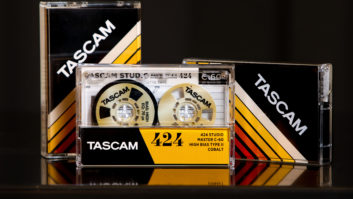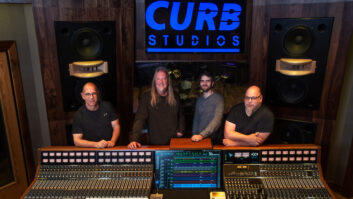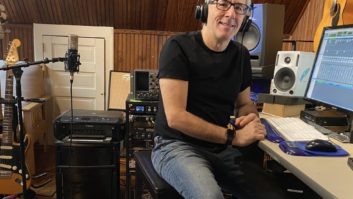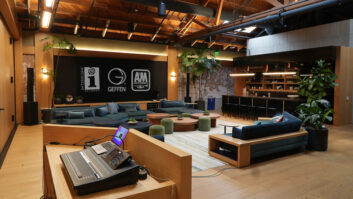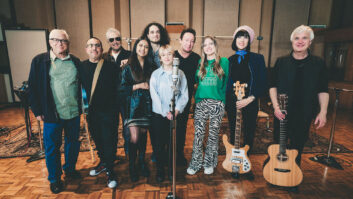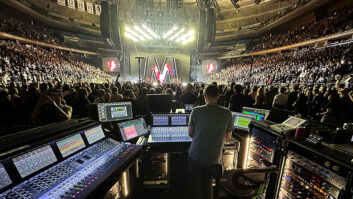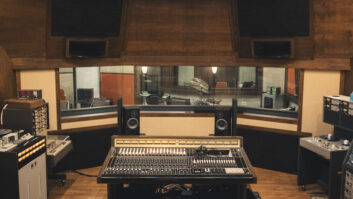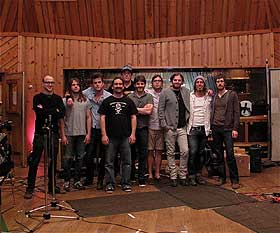
The years come and go, equipment changes, trends evolve and still the great digital vs. analog debate continues. Not that it’s really a fair fight at this point. After all, digital recording formats have become completely ubiquitous, admired for their ease of use, sonic transparency, cost-effectiveness and, increasingly, the variety and quality of compatible signal processing plug-ins available in the digital realm. But wait a minute—you still need the gear that gets you to your DAW, which certainly includes a mic preamp and perhaps some of the cool outboard boxes that discerning ears argue still sound better than most plug-ins. Your tools of choice may also call for an all-in solution like an analog console that provides the input, processing and a mix summing platform for one last look at analog before the audio goes digital for distribution.
In Avatar Studios are (L-R) Bob Mallory (assistant engineer), Matthew Followill, Jared Followill, Brent Rawlings, Jay Schleusener, Jacquire King, Nathan Followill, Caleb Followill, Angelo Petraglia (producer), Brad Bivens
But what about tape? Ah yes, that tool of recording’s dark ages. Even though the availability of the product has returned after its initial fall from use, it’s expensive, noisy (compared to digital) and famously cumbersome to work with. That is so 20th century! But it is also a technology that a vocal minority of engineers and producers—young and old—have embraced in recent years, with a modern twist: They use tape for its sonic properties, but also employ digital media for its editing and storage capabilities. This is not exactly news: All through the so-called “digital revolution,” there have been folks who have recorded, say, drums, bass and guitars to analog tape and then transferred to Pro Tools, Nuendo, etc., for editing. But some of today’s hybrid enthusiasts are now finding ways to work with tape throughout the recording process, combining the best of the analog and digital worlds. Mix recently spoke with four Tape True Believers about their affection for the whirring reels and mysterious properties of magnetic tape.
JACQUIRE KING
During the past 15 years, Jacquire King has been involved in a slew of interesting albums by the likes of Smash Mouth, Tom Waits, Modest Mouse, Norah Jones and—most famously, perhaps—Kings of Leon. When we catch up with King, he is at different stages of work on two albums: Kings of Leon had worked on their next album at Avatar in New York and Blackbird in Nashville, and now King was mixing at his home studio in Nashville; and L.A. band Cold War Kids had recorded at Ocean Way and House of David in Nashville, and were planning to go out to Sunset Sound in L.A. this month as they toil away on an album expected early next year.
“I like to use a console and tape machine and more of an ‘old-school’ traditional studio setup in part because they’re tools that are more about using your hands and ears—your ears, especially—as opposed to a computer,” King comments. “Don’t get me wrong—I use the computer and have for a very long time. I’ve had Pro Tools since it was a baby—and since I used to swear up and down I’d never use a plug-in! But atmosphere-wise and vibe-wise, I think recording on tape creates something people feel more invested in and there’s a romanticism to it; people get excited about that. It just creates a different level of purpose and awareness. People feel like, ‘Oh, we’re going to tape!’ It puts people on a different wavelength as far as how they’re working. If you’re recording just to digital, you can get into the mind set of, ‘Oh, it doesn’t matter, we can always do more takes, you can chop it together.’ There’s some of that attitude, which is not anybody’s fault and I’m not even saying it’s bad—it’s just the way the world works now.
“The other thing that tape does and digital can’t do—and plug-in emulation still can’t do—is the tape saturation, the handling of transients. Digital is a perfect linear playback device, and a tape machine is not perfect, which is one of the things I love about it. Tape is wiggling around, no matter how good the machine is, and that does something to the sound. And tape machines have their frequency curves and what they accentuate and what they don’t, and how they roll off a top end and all those sorts of things, so I love it for the sonics, as well.
“I mix in a hybrid situation. I mix from Pro Tools with a lot of stems, use a lot of analog inserts, parallel compression, but I use Pro Tools as more than just a playback device. Of course, I use it for editing. What I’ve discovered is I get better mixes in the hybrid scenario if I’ve recorded to analog—if my individual tracks have seen a tape machine—because there’s more consistency with the transients, with the shape of them, the tone of things and the sustain and depth, because tape squishes things and mangles things a little bit, but in a very usable, pleasing and musical way. I end up EQ’ing and compressing less in a mix because I’ve already used the tape to help me achieve a more musical sound.”
Is anything lost in the analog sound in the translation to Pro Tools? “A little bit, but when I’m tracking I’m always monitoring through Pro Tools, so in terms of conversion or how the sound is going to change, I’m always listening to that so it doesn’t take me by surprise. In some cases, too, I’ve captured [the performance] digitally and then during the mix bounced it off a wonderful ATR-102 tape machine I have to still get the analog sound. It’s not the same as going straight to the tape machine and then transferring—you’re dealing with two times conversion—but it’s a safety net. Primarily, I want my analog involvement to be multitrack.”

Dave Simon-Baker works out of Mission Bells in S.F.
DAVE SIMON-BAKER
For San Francisco Bay Area–based engineer/producer/musician Dave Simon-Baker, whose recent work includes the latest albums by the Mother Hips (Pacific Dust), ALO (Man of the World) and Jackie Greene (Till the Light Comes), his return to using analog tape (with Pro Tools) was influenced in part by the arrival of a very special machine at the studio he calls home these days, Mission Bells in S.F.: a Studer A820 24-track that was owned by the notoriously audio-conscious Grateful Dead (and used to record their final two albums in the late ’80s). Greene, who co-owns Mission Bells with Mother Hips leader Tim Bluhm, acquired the Studer through former Dead bassist Phil Lesh, in whose band he played part-time during 2007/2008. The machine wasn’t working when it was lugged up the stairs to the second-floor studio, but some remedial work courtesy of ex-Grateful Dead sound wizard John Cutler and, especially, Krieg Wunderlich changed that, and now, “It’s the most amazing-sounding recorder!” Simon-Baker says. “That is a special machine. I’d used the Studer A80 a lot and liked it, but I didn’t realize until I started using this A820 that it has built-in Dolby SR card slots, so we did most of the Hips record and all of Jackie’s at 15 ips with Dolby SR and it sounds great; it just kicks huge ass. The clock is so amazing on it and the sound is so rich and full.
“I had stopped using tape entirely for 12 years and it wasn’t a conscious choice—it was economics entirely. People weren’t affording it; they didn’t want to buy it. So I found myself with a roomful of hard drives, and I felt like, ‘Where? Why?’ So when the opportunity came to use this beautiful machine, I fell back in love with it. It takes a little more time because of the transferring [back and forth between it and Pro Tools] and I know there are systems where you can avoid that, but we have it set up in a way we can work well with it.”
The Hips and Greene albums were being worked on concurrently (in fact, the Hips play on much of Greene’s album and Tim Bluhm also co-produced), and as economic considerations were important in both cases, Simon-Baker was careful not to use too much tape—not a problem given his recording M.O. “We monitor through Pro Tools, but we don’t actually record to Pro Tools until it’s been on tape. Then I transfer it over when the tape is full. The masters were all on Pro Tools. Then we’d just erase the tape when we were done and we’d keep going over the same tape. The Hips record and the Jackie record were done on a total of about four reels of tape.”
Greene’s album, in particular, has a somewhat ’60s psychedelic sound, but that’s mostly because of the arrangements and instrumentation—it’s rife with Rickenbacker guitars and bass, B-3 organ, even electric sitar on two songs (backward on one). “Tape helps get some of that feeling,” Simon-Baker says, “but more is the playing and the instruments and the amps. Jackie and Tim are staunch collectors and a lot of the sound is classic guitars through classic amps—a lot of Princeton amps and that sounds fantastic; Vibrolux; Super Reverb. That gives it more of that sound than the tape. We also have nice preamps—we use a lot of Neve and API stuff, and the new Mercury M72.
“But now that I’ve had this opportunity to get back to tape, I realize the sum effects of putting all those tracks down gives it a particular way of sitting together. It’s almost like a smearing effect where everything sits in a real warm and comfortable zone, and it layers a bit more naturally. It sits in a certain way and creates more of an illusion than the clarity of digital. And I like the sound of digital.”

Bryan Lenox: “You’d be amazed with the difference in Michael [W. Smith’s] singing because of hearing himself analog in the playback.”
BRYAN LENOX
Nashville-based Bryan Lenox has extensive engineering, production and programming credits in the enormous Christian music community, including several albums with top-selling artist Michael W. Smith. Until recently, all the albums Lenox had cut with Smith were recorded digitally, but for Smith’s next, still untitled album (due this fall), the engineer made the bold move back to tape—sort of. Actually, Lenox is one of a growing number of people who have adopted the Endless Analog CLASP (Closed Loop Analog Signal Processor) two-rackspace box that, as Mix’s technical editor Kevin Becka explained in a rave review of the product in our June 2010 issue, “offers an easy, cost-effective way to integrate analog tape into digital production workflow by literally turning any tape machine into a DAW plug-in processor.”
“This has been life-changing in terms of how I view recording,” says Lenox, who has his own mix room called the Bird House in a larger facility known as The Coop, owned by another popular Christian artist, Toby McKeehan (better known as tobyMac). “CLASP is a device that allows you to record to analog tape by taking an instant virgin transfer off the repro head [of the recorder] into your DAW, whether it’s Pro Tools or Nuendo or whatever, Mac or PC. And the way it works, your mic pre’s and your inputs come into CLASP, and it splits it—one’s a hard-wire split that goes straight to your mixing console as you’re playing, if you were on ‘input’; the other split goes to the 2-inch machine or 1-inch or whatever you’re using and it takes it off the repro head so the amount of time the sound is on the tape is very, very brief. It only stays on there as long as it goes through the record head and out the repro head because then it’s instantly transferred into whatever DAW you have. But it’s on there long enough to get the benefits of tape compression and whatever it is that sort of glues the sound together.
“Another thing that’s been remarkable,” Lenox adds, “is back in the old days, without the CLASP you had to choose either 30 inches per second or 15 inches per second, and that’s it; you’re locked in at that tape speed. Well, CLASP allows you choose to record the drums at 30 ips in the verse and 15 ips in the chorus if you want, or you can go down 7½ or 9 or 12; whatever you want. So for the first time you’re able to really use any speed you want and you can quickly compare between the speeds and choose the one you want. We’ll audition as we’re going along and it’s remarkable for the guitarist or bassist to be able hear how it sounds at different speeds.
“You’d also be amazed with the difference in Michael’s singing because of hearing himself analog in the playback. We’ve also lowered some of the keys so his voice is bigger and he’s a lot more expressive. All in all, it’s had a huge impact on the performances—we’re making a much more emotional album.”
Smith was evidently impressed, too. He bought the CLASP box after the sessions and now it can be an ongoing part of his (and Lenox’s) recording arsenal.
DAVE COBB
“I use tape every day,” says L.A. producer/engineer/musician Dave Cobb (Shooter Jennings, Brooke White, Oak Ridge Boys). “It’s funny because I was one of those people who about eight years ago slowly stopped using tape. I thought digital sounded fine, you can work faster, more conveniently. But the records that have really inspired me the last couple years have been very, very tape-centric. I think Jack White is kind of killing everybody right now—he’s the guy who is making the coolest-sounding records around, whether it’s the Dead Weather or The Raconteurs; he’s the guy to beat right now. His records sound honest and real, and in a way he’s making something that is very traditional sound modern and exciting again.

L.A.-based producer/engineer/musician Dave Cobb says he uses tape every day.
“I just did a record in Nashville by these two girl singers—the Secret Sisters [Laura and Lydia Rogers of Muscle Shoals, Ala.]—and the whole record is supposed to sound ‘period,’ like it’s from 1957 or something. So, of course, I wanted to go analog on it, but if I turned in a budget that said ‘12 grand for tape,’ people would have a heart attack. That’s the way it used to be—you would allot $10,000 or $12,000 dollars for tape. Nobody gets that anymore.”
For Cobb, too, CLASP aided his return to the sonics of analog tape. “It’s changed my work flow dramatically,” he comments. “CLASP allows me to use the same tapes—my favorites are these old [Ampex] 456 reels I use over and over—and dump each take I do immediately to Pro Tools. I like to do pre-production in the studio where tape is rolling the whole time while bands are working out the songs, and I couldn’t do that if I strictly stayed on tape unless I had a huge budget and a big pen to mark down the times between each take and what was special about them and all that. The CLASP allows me to run tape, keep creating playlists inside Pro Tools, and then when I’ve got what I need I just comp it together.”
For the Secret Sisters’ forthcoming album, which was cut at Blackbird, Cobb also enlisted ’50s Nashville players like steel player Robbie Turner and pianist Pig Robbins for that extra dose of retro authenticity, and he used “old-school” tape effects: “One thing I don’t ever go without is tape slap,” he comments. “I use a lot of slap and feedback slap and distorted slap and reverse tape stuff and flanging. I have two 2-track machines in the control room so I’m constantly messing around with those. For instance, a 15 ips slap always works with any tempo of any song for some reason. I don’t know why it is, but you can put it on the drums or it will help to tie a vocal with a track. Even if you barely hear the slap and it’s buried, it still has a way of making the vocal sit. My heroes are people like Geoff Emerick and Glyn Johns and Andy Johns, who really pushed the limit with tape effects. I think there’s nothing that beats them. There’s no digital box you can buy, no plug-in that sounds like a tape slap.”
ANALOG TAPE SUPPLIERS
ATR Magnetics
RMGI
Blair Jackson is the senior editor of
Mix.
